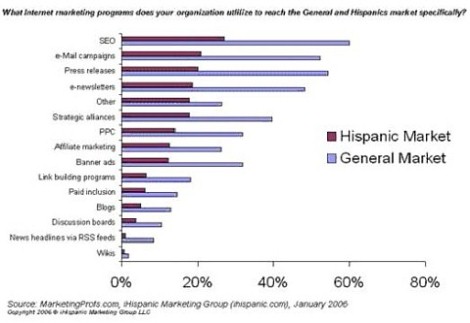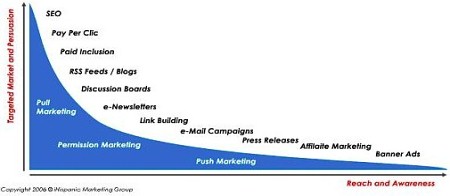Last week, we ended part 1 of this two-part series with a quick discussion of the perceived entry barriers to marketing to Hispanics. We now take a brief look at the tactics that marketers use to reach the Hispanic market, and discuss in depth search engine marketing (SEM) as an optimal way of reaching Hispanics.
Marketing Tactics
The next chart shows how marketers attempt to reach both the general and the Hispanic markets. The chart does not reflect the about of budget allocation, but merely whether a marketing tactic is used.

It's clear that search engine optimization is the most popular marketing tactic; more importantly, however, it's likely the most important internet marketing effort because it relies on a pull strategy, based on users' needs, rather than a push strategy that's focused on brand awareness and potential reach.
The following chart provides a visual presentation of how pull marketing attracts a more targeted market and is based on persuasion, whereas permission marketing is more about communities, occupying a middle ground in consumer's intent, and push marketing is used more for reach and awareness.

Search engine optimization should be viewed not as an advertising expense but as an investment that cleans up the company's Web site assets, making them accessible and relevant to all search engines. Once such an investment is made, it's all about maintenance—keeping up to date with the updates of the search engines' algorithms. Along with Web site optimization, paid search has proven to be a low-cost to acquire new customers and a powerful way to convert visitors into buyers or leads. However, pay per click (PPC) is also tied to an advertising budget; and when the money runs out, so does your text-based ad on the search engine, leaving potential interested users unattended. Each company will have its own goals; however, if feasible, it's important to have a consistent advertising effort throughout the year to ensure frequency and reach.
When it comes to reaching Hispanics, search engine marketing is highly underdeveloped, with Hispanic advertising agencies having ignored search due to a lack of knowledge about the tools and techniques of SEM. The general market was once underdeveloped as well, eventually leading to the establishment of the SEM industry. Search was ignored because companies' Internet budgets were too small and in some cases incorrectly spent. The market, however, is not small at all. According to a recent Piper Jaffray "Company Report,"(pdf), the value of the paid search market alone is expected to total $14 billion dollars in 2006 and will grow to $34 billion by 2010. This figure does not include SEO, and so the overall market is much larger than that.
US Hispanic advertising agencies do have the opportunity to get educated in search marketing. Danny Sullivan, editor of SearchEngineWatch.com, has produced multiple conferences in the United States every year since 1999. After solid growth in the industry, IncisiveMedia has now added an entire event called Search Engine Strategies Latino, scheduled for July 10-11, 2006, focused on the US Hispanic and Latin America market. To learn more, visit www.jupiterevents.com/sew/latino06/.
In part 1, we referred to the language barrier as an important challenge. Perhaps the second-highest hurdle is the lack of tracking marketing results within the Hispanic market. The analysis and reporting of Web site traffic via Web analytics programs and services is a good example. Most decision makers will look only at the number of visitors and pageviews of their Web properties, but there is so much more. And it's not expensive to delve deeper. Google Analytics (https://www.google.com/analytics/), formerly Urchin, is now free (here's a quick explanation of how it works). Other companies offer Web analytics products and services as well, such as WebTrends, WebSideStory, Omniture, and Coremetrics. Hispanic businesses and advertising agencies need only make use of them; and if they were to do so, our survey would not find that 30% of respondents don't target Hispanics because "Senior management is not convinced on the ROI."
When it comes to search engines, some believe that there is only one option for targeting Hispanics: Spanish-language search. Instead, we should be looking at the bigger picture: Hispanics doing search in any language.
What is so incredible about search, in general, is what John Battelle, author of the The Search: How Google and Its Rivals Rewrote the Rules of Business and Transformed Our Culture (Portfolio, 2005), calls "The database of Intentions," and it goes like this:
The Database of Intentions is simply this: The aggregate results of every search ever entered, every result list ever tendered, and every path taken as a result. It lives in many places, but three or four places in particular hold a massive amount of this data (i.e., MSN, Google, and Yahoo). This information represents, in aggregate form, a place holder for the intentions of humankind—a massive database of desires, needs, wants, and likes that can be discovered, subpoenaed, archived, tracked, and exploited to all sorts of ends. Such a beast has never before existed in the history of culture, but is almost guaranteed to grow exponentially from this day forward. This artifact can tell us extraordinary things about who we are and what we want as a culture. And it has the potential to be abused in equally extraordinary fashion.
So the advertiser doesn't control what the user wants; only the user controls what he or she wants, and that can be done in any language. It's common for the thought process of US Hispanics to take place in English and so they speak in English, or other times to think in Spanish and so speak in Spanish. The same is true of search: The Hispanic user will search in both languages, based on their "desires, needs, wants, and likes that can be discovered, subpoenaed, archived, tracked, and exploited to all sorts of ends."
So, if SEO, paid search, affiliate programs, and other marketing initiatives are so important, where do Hispanic ad agencies fit in? Do any of them offer these types of efforts?
Today, they really don't, because most of them do not receive budgets from their clients to justify an investment in these areas. And sometimes for good reason. For example, during our investigative process in early January 2006, one of the top 10 Hispanic advertising agencies told us that it offered SEM. We did a little more digging—and, believe it or not, found that the agency had one part-time intern taking care of the entire search engine marketing department.... We were shocked. That agency manages hundreds of millions of dollars for clients.
So here is what keeps me up at night worrying about the US Hispanic and the Latin American markets: If Latino-focused ad agencies merely add SEM or any other Internet-based programs to their list of services as if it were just an SKU and pretend to know how to implement them—but don't deliver results—clients will rightly be frustrated. As a result, such agencies are damaging the entire industry.
SEM requires a full commitment to learn; and it doesn't take a couple of days to pick up, either. To drive results, as with all media, it takes practice and skill. Ad agencies must invest the time and human resources to be able to deliver results. Imagine what happens when a client who allocated $20 million from the marketing budget finds out that an intern is handing its SEM campaign.... A viable option for Hispanic ad agencies is to partner with market leaders, which was the most likely case among those we tracked that were offering search marketing solutions in a professional manner.
Rob Laporte, CEO of Internet marketing firm DISC, explains that SEM consists of two distinct activities: SEO (search engine optimization) and paid placement. It requires exceptional linguistic and technical aptitude, and ongoing research and training. Therefore, a manager who would like to have SEM expertise in-house should expect to allocate at least $60,000 (in the US) toward employee salary and training. Good programmers rarely make good search engine marketers, because of the highly linguistic nature of the work; a manager should be cautious about using on-staff Web programmers for SEM. Marketing personnel may have the linguistic and product knowledge, but they need to have substantial technical knowledge of Web programming relating to search engines.
Even in SEM firms, it is rare for one person possess sufficient mastery of the various fields of knowledge that SEM makes use of, and people who do have such mastery are likely to cost more than $60,000 per year.
The following is culled from and based on Laporte's listing of the skills needed for SEM:
- Linguistic aptitude: SEM is primarily a linguistic activity, wherein you match the query language of searchers with the language of your advertising and Website through the nexus of search engines. Our experience has shown that engineers and artists (Web designers), though sometimes able to write well, are rarely motivated to master language and writing to the high degree needed for successful SEM. Linguistic aptitude alone is not enough, but it is absolutely required.
- Research skills: Knowing what one doesn't know, and being humble about what one does know, are key characteristics behind the sharp, ongoing research needed to maintain mastery of the various technical fields that SEM makes use of. For example, how easy would it be to separate some static optimized pages from your company's dynamic Web publishing system? Is your current server statistics package sufficient for tracking SEM results, or should you consider a more devoted software solution? When should you use the robots.txt file and how? What kinds of JavaScript menus can Google follow, and where should the JavaScript be written? How can Flash be used while preserving SEO? Does your site have a static IP address? What usability and navigation principles ensure that the traffic you get will convert optimally? These are just a few of the myriad questions that SEM deals with. The more technical and Web marketing knowledge a SEM person has, the better; but a good researcher will be able to find and assess questions and answers when needed.
- Technical aptitudes and experience: The more experience with Web programming technicalities possessed by an SEM person, the better. The SEM person can research answers on the Web or in consultation with an SEM vendor or an in-house IT person, but this research still requires some technical aptitudes and some technical background.
- Can one person do it all? Rarely. SEM has become a major discipline, consisting of both science and art and spanning marketing and Web technology. If you are to hire or cultivate an in-house person, that person should work with a team that can address both technical and marketing problems and opportunities.



